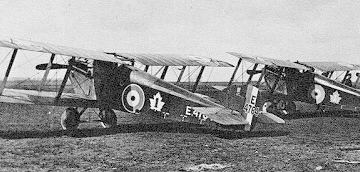Nickname(s) Nick Rank Major Years of service 1911–1919 | Buried at Old Shoreham Cemetery Name Albert Carter Unit No. 19 Squadron RAF | |
 | ||
Died May 22, 1919, Shoreham-by-Sea, United Kingdom | ||
Albert Desbrisay Carter DSO & Bar (2 June 1892 – 22 May 1919) was a Canadian World War I flying ace credited with 28 victories.
Contents
- Early life and career
- Service as a fighter pilot
- Post World War I
- Distinguished Service Order
- Bar to Distinguished Service Order
- References
Early life and career
Albert Desbrisay Carter was born in Point de Bute, New Brunswick.
Carter originally joined the 13th Reserve Battalion of the Canadian Expeditionary Force and was commissioned in March 1911. In May 1917, although he already held the rather senior rank of major, he was transferred to the Royal Flying Corps Number 1 School of Military Aeronautics. On 7 July 1917, he was remanded to Number 1 Training Squadron. Later that month he moved on to Number 20 Training Squadron. He finished his training with Number 56 Training Squadron in August.
Service as a fighter pilot
On 1 October 1917, Carter received an assignment to No. 19 Squadron, where he remained until war's end. On 31 October, he opened his career with an Albatros D.V destroyed and another German plane driven down out of battle. On 13 November 1917 he became an ace on the third of the six victories he would score that month. Also in November, he became a flight leader. By the end of the year, on 29 December, he would score his fifteenth and final triumph flying a SPAD.
His next victories would not come for another two and a half months. He had an opportunity when he engaged enemy two-seaters, but was thwarted by a broken gunsight on his newSopwith Dolphin. Then, on 15 March 1918, he destroyed one Pfalz D.III and sent another one down out of control. He would score an even dozen times flying the Dolphin, with his final success falling in flames on 16 May 1918. His final tally was 14 enemy driven down out of control and 14 destroyed. Seven of his victories were shared with other pilots. Twenty of his 28 victims were enemy fighters.
On 18 March, Major Carter was shot down by German ace Lieutenant (Leutnant) Paul Billik. Carter fell behind German lines, survived the crash, and was captured. He finished his war in a prisoner of war camp. He received the Distinguished Service Order, while in prison, on 18 July. It was followed by the unprecedented bestowal of a Bar, equivalent to a second award, on 16 September 1918. He was repatriated on 13 December 1918.
Post World War I
Carter then joined the Canadian Air Force and was posted to No. 123 Squadron . On 22 May 1919, Carter was killed in a flying accident while test flying a Fokker D.VII; the plane broke up under him. He was buried at Old Shoreham Cemetery, Shoreham, Sussex, England.
Distinguished Service Order
"Maj. Albert Desbrisay Carter, Infy., and R.F.C. For conspicuous gallantry and devotion to duty. He destroyed two enemy aeroplanes, drove down several others out of control, and on two occasions attacked enemy troops from a low altitude. He showed great keenness and dash as a patrol leader."
Bar to Distinguished Service Order
"Maj. Albert Desbrisay Carter, D.S.O., New Brunswick R., and R.A.F. For conspicuous gallantry and devotion to duty as a fighting pilot. In three and a half months he destroyed thirteen enemy machines. He showed the utmost determination, keenness and dash, and his various successful encounters, often against odds, make up a splendid record.
Carter also received the Belgian Croix de Guerre.
